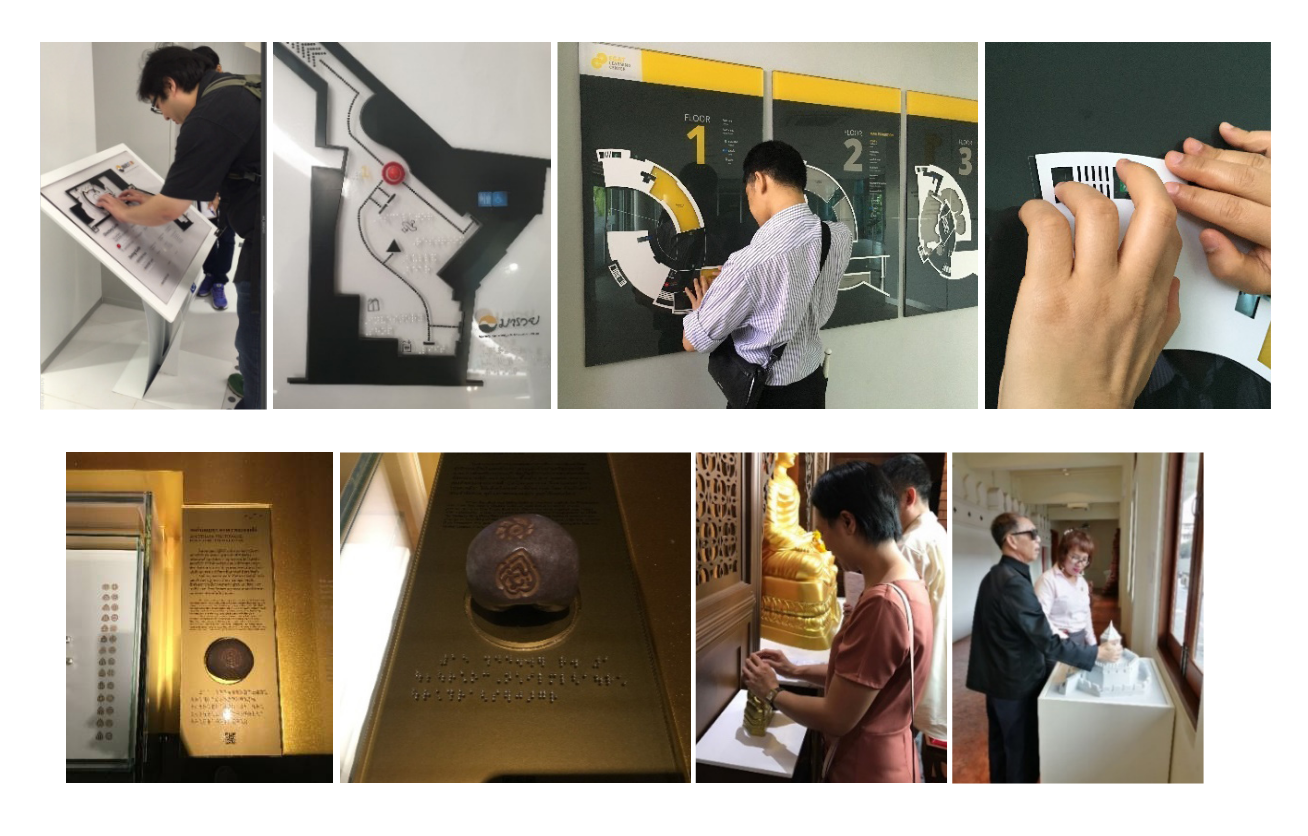Design Guidelines: Museum and Learning Center for the Blind
Main Article Content
Abstract
The concept of modern museum and learning center are places for learning that everyone can access and use. But most of them the blinds cannot access because of physical limited and display methods. The objectives of this research were 1) to study the physical environment and facilities 2) to study how the information access and design the media for the blinds 3) to study the problems and limitations 4) to suggest suitable design of the physical environment, facilities, exhibition displays, and medias. The research tools were observation, interview, data collection in 4 places of museums and learning centers. By create sample information or tactile boards for experts to evaluate, then analyze data and suggestions design guidelines. Afterward, 19 experts from agencies involved in the blind assess the completed exhibitions again. The result of the assess shows that they need physical accessibility which 1) easily to understanding routes, that the same routes as the general people, not divided. 2) Tactile surfaces, must be protrude and be international standards. 3) Other building elements in accordance with standards and regulations. 4) Registration point is the same level as general people. Information accessibility should have 1) Information signage and labels should have braille with standard size, but not too long. 2) Audio description is the easily media for all. 3) Having QR code and QR Braille to get more information. 4) The exhibition items should have media for listen while touching. 5) Having tactile map in order to know the scope of buildings and facilities. The services provided by the tour staff are also very necessary.
Downloads
Article Details

This work is licensed under a Creative Commons Attribution-NonCommercial-NoDerivatives 4.0 International License.
All material is licensed under the terms of the Creative Commons Attribution 4.0 International (CC-BY-NC-ND 4.0) License, unless otherwise stated. As such, authors are free to share, copy, and redistribute the material in any medium or format. The authors must give appropriate credit, provide a link to the license, and indicate if changes were made. The authors may do so in any reasonable manner, but not in any way that suggests the licensor endorses you or your use. The authors may not use the material for commercial purposes. If the authors remix, transform, or build upon the material, they may not distribute the modified material, unless permission is obtained from JARS. Final, accepted versions of the paper may be posted on third party repositories, provided appropriate acknowledgement to the original source is clearly noted.
References
Ariyaprasert, C. (2013). A standard guide to presenting the content of museums and learning centers in public buildings, with universal design. Retrieved from https://dol.thaihealth.or.th/Media/Index/4f8745fe-4df3-e711-80e3-00155d65ec2e.
Bentzen, B. (n.d.). Detectable Warnings in Transit Facilities: Safety and Negotiability. Washinton, DC: n.p.
Cioffi, J. (2015). What is Tactile Map. Interview by S. Jiravanichkul [Memos]. CEO& Co-founder of ClickAndGo Wayfinding Maps and InTouch Graphics. Inc.
Jarutach, T. (2018). Universal Design. Bangkok: Chulalongkorn University Press.
Majewski, J. (n.d.). Smithsonian Guidelines for Accessible Exhibition Design, Smithsonian Accessibility Program. Retrieved March 16, 2015 from https://www.americantrails.org/images/documents/Smithsonian-Accessibility-Program.pdf
Ministry of Interior. (2005). Facilities in the building for the people with disability or the disabled and the elderly, B.E. 2548. Retrieved June 17, 2015 from http://law.m-society.go.th/law2016/law/view/136.
Ministry of Social Development and Human Security. (2020). Situation of the people with disability in Thailand. Retrieved March 31, 2020 from http://dep.go.th/Content/View/6113/1
Ministry of Social Development and Human Security. (2009). Convention on the Rights of Persons with Disabilities (CRPD), B.E.2552. Bangkok: Idea Square Limited partnership.
Ministry of Social Development and Human Security. (2012). The arrangement of equipment’s facilities or services in buildings or other public services for people with disabilities accessibility and use, B.E.2555. Retrieved March 11, 2020 from http://law.m-society.go.th/law2016/uploads/lawfile/20150119_14_34_23_2161.pdf
Nak-amma, U. (2018). Tactile map for the blind. Interview by S. Jiravanichkul [Memos]. Officer of Thailand Association of the blind.
Sethanabodi, K. (2015). Museum and learning center’s design criteria for the blind. Interview by S. Jiravanichkul [Memos].
Suppawatthanakul, K. (2013). More than four hundred thousand children with disabilities did not go to school. “Policies & Laws” is good, but the state’s action failed. Thai Civil Rights and Investigative Journalism (TCIJ). Retrieved Jun 10, 2020 from https://www.tcijthai.com/news/2013/30/scoop/3318
Sutthi, K. (2015). What is Tactile Map, Tactile block, Braille and how to use for Museum. Interview by S. Jiravanichkul [Memos]. Director of Thai National Institute for the blind.
Sutthi, K. (2016). Progress of Tactile Map and Object Model for the blind. Interview by S. Jiravanichkul [Memos]. Director of Thai National Institute for the blind.
Sutthi, K. (2019). Explore the exhibition tour route for the blind at Pipitbanglamphu. Interview by S. Jiravanichkul [Memos]. Director of Thai National Institute for the blind.
Thongsutthipeerepas, N. (2012). Interior Museum design (Teaching Document). Retrieved May 11, 2020 from https://issuu.com/jew-nathrathanonthongsuthipheerapas/docs/18


